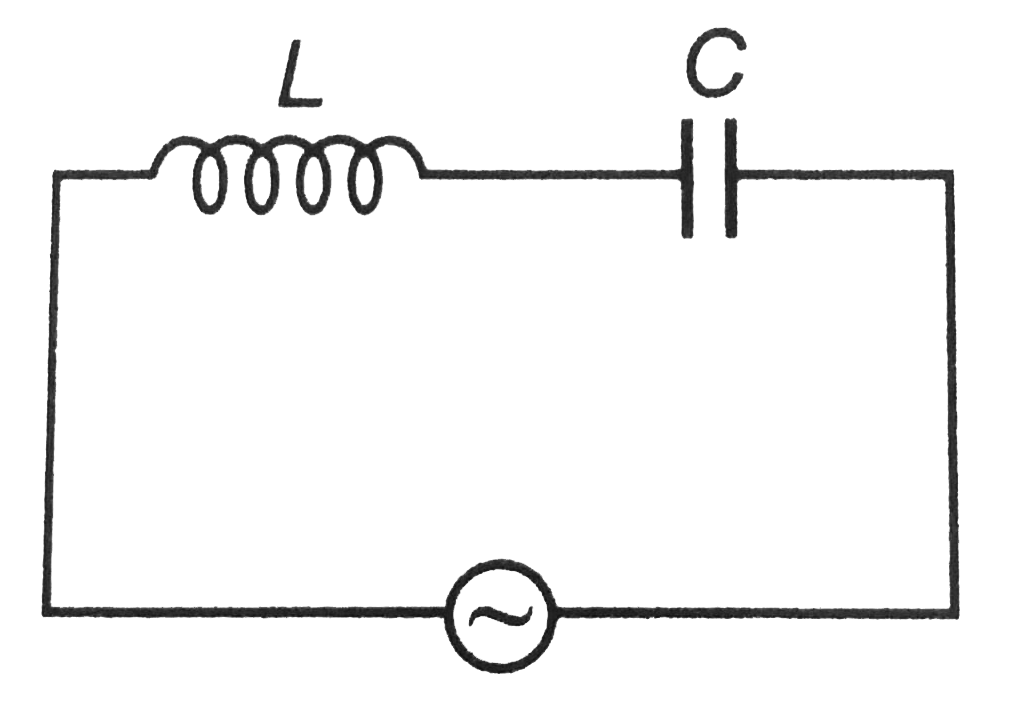Answer the following questions :
(a) In any a.c. circuit, is the applied instantaneous voltage equal to the algebraic sum of the instantaneous voltages acorss the series elements of the circuit ? Is the same true for r.m.s. voltage?
(b) A capacitor is used in the primary circuit of an induction coil.
(c ) An applied voltage signal consists of a superposition of a d.c. voltage and an a.c. voltage of high frequency. The circuit consists of an inductor and a capacitor in series. Show that the d.c. signal will appear across C and the a.c. signal will appear across L.
(d) A choke coil in series with a lamp is connected to a d.c. line. The lamp is seen to shine brightly. Insertion of an iron core in the choke causes no change in the lamp's brightness. Predict the corresponding observation if the connection is to an a.c. line.
(e) Why is choke coil needed in use of fluorescent tubes with ac mains ? Why can we not use an ordinary resistor instead of choke coil?
(a) Yes: the statement is not for rms voltage
It is true that in any ac circuit, the applied voltage is equal to have average sum of the instantaneous voltages across the sereis elements of the circuit, however, this is not true for rms voltage because voltages across different elements may not be in phase.
(b) High induced voltage is used to charge the capacitor.
A capacitor is used in the primary circuit of an induction coil. this is because when the circuit is broken, a high induced voltage is used to charge the capacitor to avoid sparks.
(c) The dc signal will appear across capac itor C because for dc signals, the impedanc eof an inductor (L) is negligible while the impedence of a capacitor (C) is very high (almost inifinite). Hence, a dc signal appears acros C. for an ac signal of high frequency, the impedance of L is high and that of C is very low, Hence, an ac signal of high frequency appears across L.
(d) If an iron core is inserted in the choke coil (whic is in series with a lamp connected to the ac line). then the lamp will glow dimly. this is because the choke coil and the iron core increase the impedance of the circuit.
(e) A choke coil is needed in the use of fluorescent tubes with ac mains because it reduces the voltage acros the tube without wsting much power. An ordinary resistor cannot be used instead of a choke coil for this purpose becaue it wastes power in the form of heat.
Topper's Solved these Questions
Similar Questions
Answer the following questions :
(a) In any a.c. circuit, is the applied instantaneous voltage equal to the algebraic sum of the instantaneous voltages across the series elements of the circuit ? Is the same true for rins voltage ?
(b) A capacitor is used in the primary circuit of an induction coil.
(c) An applied voltage signal consists of a superposition of a d.c. voltage and an a.c. voltage of high frequency. The circuit consists of an inductor and a capacitor in series. Show that the d.c. signal will appear across C and the a.c. signal across L.
(d) A choke coil in series with a lamp is connected to a d.c. line. The lamp is seen to shine brightly. Insertion of an iron core in the choke causes no change in the lamp's brightness. Predict the corresponding observations if the connection is to an a.c. line.
(e) Why is choke coil needed in the use of fluorescent tubes with a.c. mains ? Why can we not use an ordinary resistor instead of the choke coil ?View SolutionAn ac source of 50 V (r.m.s value) is connected across a series R - C circuit. If the r.m.s voltage across the resistor is 40 V, then the r.m.s voltage across the capacitor is
View Solution
Knowledge Check
- Question 1 - Select One
In an a.c. series circuit, the instantaneous current is maximum when the instantaneous voltage is maximum. The circuit element connected to the source will be
APure inductorBPure capacitorCPure resistorDcombination of capacitor and an inductor. - Question 2 - Select One
Relation between r.m.s. voltage and instantaneous voltage of an AC
AV0=VRMS/√2BVRMS=V0/√2CVRMS=0.70V0DBoth (C) and (D) - Question 3 - Select One
In a series L−C circuit, the applied voltage is V0. if omega is very low, then the voltage drop across the inductor VL and capacitor VC are
 .AVL=V02,VC=V02BVL=0,VC=V0CVL=V0,VC=0DVL=−VC=V02
.AVL=V02,VC=V02BVL=0,VC=V0CVL=V0,VC=0DVL=−VC=V02
An ac source of 50 V (r.m.s value) is connected across a series R - C circuit. If the r.m.s voltage across the resistor is 40 V, then the r.m.s voltage across the capacitor is
View SolutionIn a series LCR circuit, voltage drop axross L can be more than applied voltage (True/false).
View SolutionIn a series LCR circuit, voltage drop axross L can be more than applied voltage (True/false).
View SolutionIn a series L−C circuit, the applied voltage is V0. if omega is very low, then the voltage drop across the inductor VL and capacitor VC are
 .View Solution
.View SolutionIn an L-C-R circuit, if V is the effective value of the applied voltage VR is the voltage across R, VL is the effective voltage across L, VC is the effective voltage across C, then
View Solution

